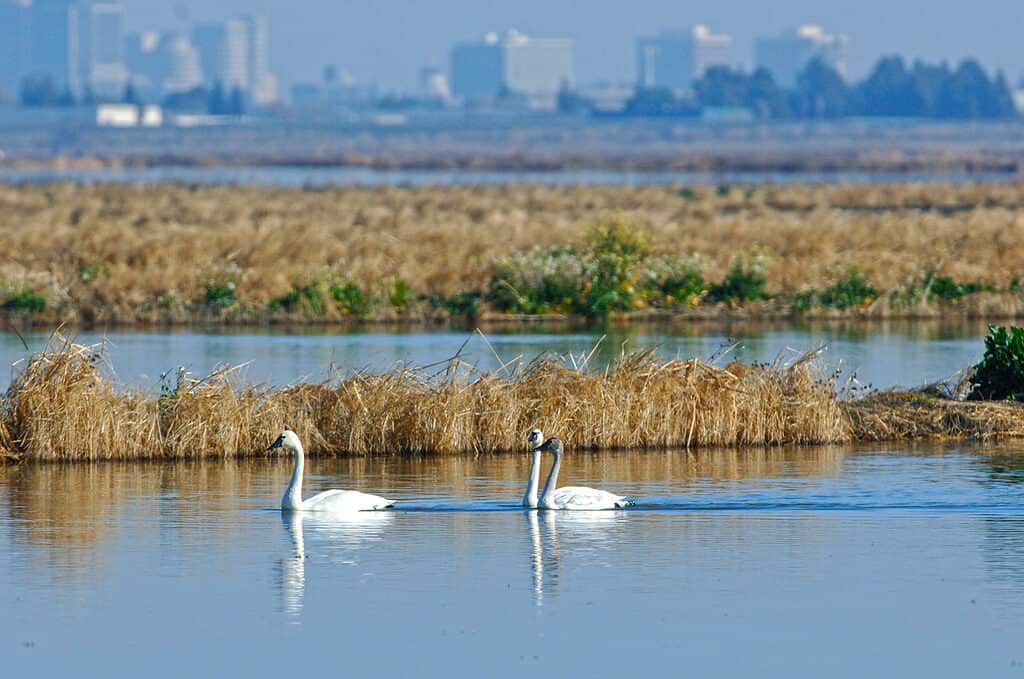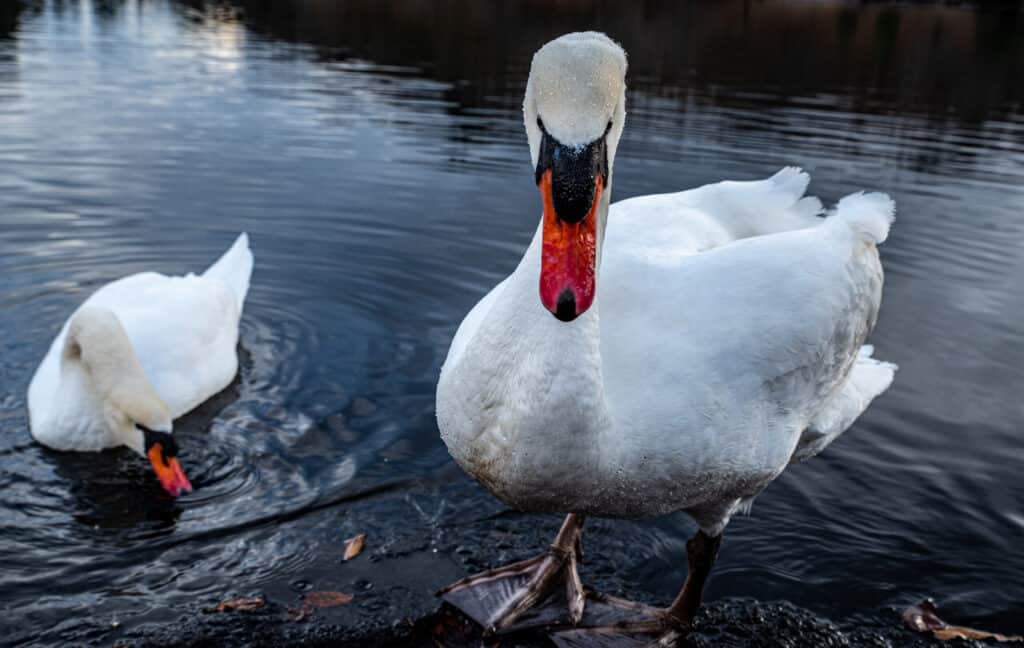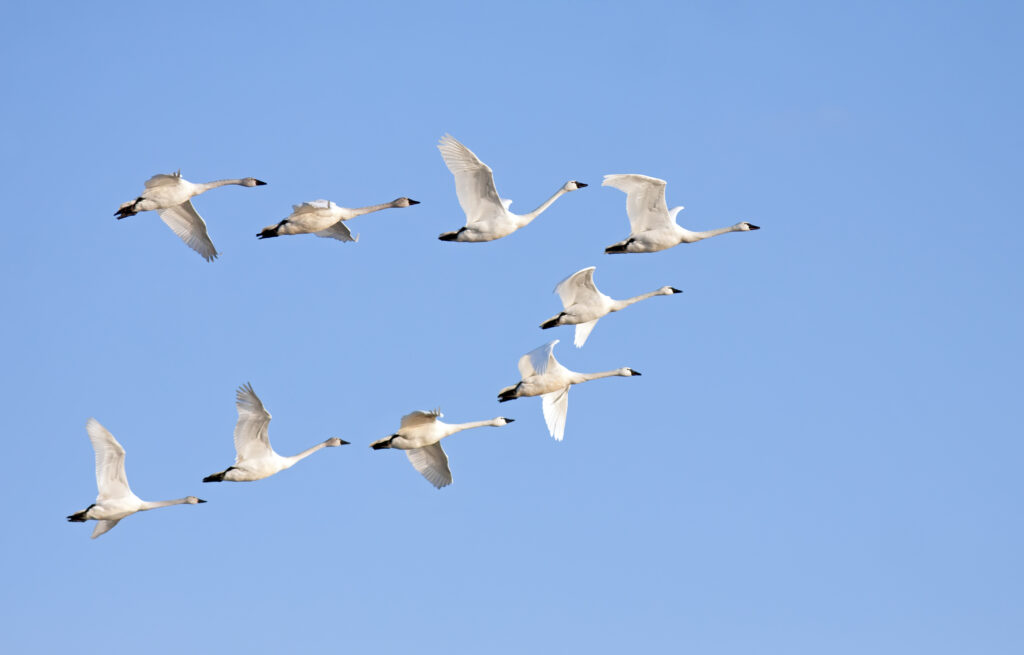As the crisp, chilly air sets in and the leaves turn to shades of red and gold, one can’t help but wonder: where do swans go in the winter?
Understanding the winter habits of swans is not only fascinating, but it also helps us appreciate the remarkable adaptations of these majestic creatures. In this blog post, we’ll explore the mysteries of swan migration and discover where they go when the chill of winter sets in.
What Are Swans?

Trumpeter swans are one of three species of swans that live in North America.
©iStock.com/Zeke1
Swans are a beloved and iconic bird species in the United States, known for their beauty, elegance, and grace. They belong to the Anatidae family, which also includes ducks and geese, and are characterized by their long necks, large wingspan, and striking plumage.
Swans are primarily herbivores, feeding on aquatic vegetation, algae, and other plant matter found in lakes, ponds, and rivers. They have a unique adaptation in their long necks, which allows them to reach vegetation growing in deeper waters. Swans will also occasionally feed on insects and small fish.
A swan can weigh up to 35 pounds and have a wingspan of more than 8 feet! Making them one of the largest and heaviest types of flying birds!
Swans are large birds typically found in wetland habitats, such as ponds, lakes, and rivers. They are well adapted to living in these environments and are known for their ability to swim, dive, and fly. However, they require large areas of open land or water to land and take off, owing to their massive size and weight.
North America boasts a diverse population of swans, with three species in the region: the native trumpeter and tundra species, as well as the non-native mute.
Out of the three, the trumpeter swan is particularly remarkable as it is the largest waterfowl in North America and the largest swan species worldwide.
Do Swans Migrate?
Yes, they do! Swans are not just stunning and graceful creatures, but they also possess an incredible ability to navigate long distances during migration. The timing and distance of swan migration can vary depending on the species and their location.
Why Do Swans Migrate?

The primary reason swans migrate, despite many being able to survive winter weather, is for food.
©Danita Delimont/Shutterstock.com
As most swan species are able to withstand harsh winter conditions, it is not the main factor that influences their migration patterns. In fact, certain populations of swans may decide to stay in colder climates, even when temperatures drop to exceptionally low levels.
The primary reason behind their migration is food. Swans usually migrate when their food sources become scarce due to the freezing of their habitats. Another reason for migration is the search for breeding grounds.
When Do Swans Migrate?

Tundra swans in North America go on long journeys to reach warmer climates during the winter.
©Sergey Uryadnikov/Shutterstock.com
During the winter, swans in the Northern Hemisphere often embark on their annual migration, with some species beginning their journey as early as October or as late as January and February, depending on the weather conditions.
In North America, trumpeter and tundra swans are known to undertake long journeys during this time, traveling to warmer climes.
Where Do Swans Go in the Winter?

Swan migration patterns depend on climate and species. When tundra swans migrate,
California
is just one of the places they may go.
©iStock.com/johnrandallalves
Swans have different migration patterns depending on their species.
Tundra swans have a unique migration pattern that depends on their breeding location. These swans typically nest in the Arctic and migrate for the winter, either west to California or east to the Atlantic Flyway toward the Chesapeake Bay area.
During their migration, the tundra swans may fly over areas where trumpeter swans have been nesting or wintering, particularly in the Pacific Northwest. This can provide a fascinating opportunity for birdwatchers to observe both types of swans in the same location.
Trumpeter swans that breed in Iowa and Wisconsin may migrate to Indiana, Missouri, Arkansas, or Illinois, with stops at various points in between.
Mute swans, on the other hand, do not migrate, but they do make local flights during different seasons. During the winter months, mute swans fly to areas with open water and often gather in large numbers to forage and find food.
While most swan species are known to migrate for the winter, there are instances when they may choose not to. In cases where there is an abundance of food available in their current location, some swans may opt to stay in the same area despite harsh weather.
What Do Swans Do in the Winter?

While they may make local flights during the winter, mute swans don’t migrate.
©TETSU Snowdrop/Shutterstock.com
During their wintering period, swans often congregate in large flocks in open water bodies, such as rivers, lakes, and coastal estuaries. They spend much of their time foraging for food, resting, and possibly engaging in courtship and mating behaviors.
How Do Swans Prepare for Migration?

To prepare for migration, swans consume large amounts of food in the weeks building up to their travels, storing their fat reserves.
©hay_mn97/Shutterstock.com
Swans typically prepare for migration by storing the fat reserves they need to sustain themselves during the long journey. They also undergo physiological changes in response to environmental cues, such as decreasing daylight and falling temperatures.
Swans will consume large amounts of food in the weeks leading up to migration to build up their fat reserves. This is especially important for migratory swans, such as Tundra and Trumpeter Swans, that will be traveling long distances.
Swans also undergo changes in their body composition to prepare for the physical demands of migration. They may increase their muscle mass and decrease their overall body weight to become more aerodynamic and better able to fly long distances. Additionally, swans may develop denser feathering to help protect them from the cold and harsh weather conditions they will encounter during their journey.
Do Swans Travel in Flocks During Migration?

Small flocks of swans fly in formation when they migrate.
©Delmas Lehman/Shutterstock.com
When migrating, swans often fly together in small flocks that usually form the traditional V-shape. These groups can include a mix of adult swans, younger birds, and breeding pairs.
Trumpeter swan flocks usually have a smaller size and consist of 10 to 25 birds. On the other hand, flocks of Tundra swans can be larger and comprise as many as 100 birds.
Where Do Swans Go in the Summer?
Before the arrival of summer, migratory swans make their way back to their breeding grounds in early spring. Swans that migrate typically depart from their wintering grounds before March or April, allowing them to reach their breeding grounds in time for the start of the breeding season.
Once they arrive, they remain in their breeding grounds throughout the summer before departing again during or before the winter season.
Do Swans Come Back to the Same Place Every Year?
Swans of all species have a tendency to return to their previous nesting sites every year, sometimes even to the exact same nest, and will work to restore and rebuild their nest whenever possible. This behavior is particularly evident if the parents have had successful broods in the past.
Additionally, swans are known for their strong territoriality. Once they have claimed a nesting site, they are unlikely to abandon it easily – they are not inclined to build their nest in any other location besides their own.
The photo featured at the top of this post is © OlegRi/Shutterstock.com
FAQs (Frequently Asked Questions)
How far can a swan fly?
Swans are strong flyers and can travel long distances of over 1,000km, though they often migrate in stages.
How long can a swan fly?
They can fly up to 620 miles in 12 hours, reaching speeds of around 55 miles per hour. While on the move, these birds travel several hundred miles each day, averaging a speed of 18 to 30 miles per hour and flying at elevations of 6,000 to 8,000 feet.
What is special about swans?
Known for their high level of intelligence, swans display a great deal of devotion towards their mate and exhibit a remarkable level of aggression in defense of their young.
Do swans migrate at night?
During migration, swans are known to travel both during the day and at night.
Do swans have good memory?
Similar to elephants, swans are recognized for their impressive memory. They have the ability to recall situations in which they have been treated kindly or harshly.
Do swans always live in pairs?
Swans are known to establish monogamous pair bonds that endure for numerous years. In some instances, these pair bonds may even last for the entirety of the swans’ lives. Their loyalty to their mates is so well-established that the sight of two swans swimming together with their necks forming a heart shape has become a near-universal symbol of love.
Thank you for reading! Have some feedback for us? Contact the AZ Animals editorial team.






